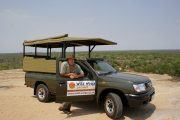The last few safaris brought it fair share of exciting animal behaviour. Something that consistently came up, were predators and kills. We’ve had some amazing sightings, like the photo I took of the lion feeding on the giraffe. We were also caught unaware as a sudden burst of action next to the vehicle ended up being a leopard catching an impala. After dragging the impala under a bush, it decided to hide until night time before coming back to feed. Another spectacular kill came from a group of 4 lions. They were slowly approaching a herd of impala, and circling it. Initially the impalas noticed them and started to scatter, but one young male started running ahead and cornered a smaller group of impala. This was very smart as the impalas started running straight towards it. Upon noticing the lion they changed direction, and one unfortunate impala ran straight into another female that was crouched on the sandbank. In trying to avoid it, the impala tried to jump right over the lioness, but the agility of the big cat proved to be too much as she pulled the impala straight out of the air and killed it within seconds. The rest joined for the small feast, and finished the meal off within 5 minutes.
Simon Vegter
<a href="http://www.wild-wings.co.za">
__________ Information from ESET NOD32 Antivirus, version of virus signature database 3594 (20081107) __________
The message was checked by ESET NOD32 Antivirus.
http://www.eset.com
+(Medium)-707938.jpg)

.jpg)
.jpg)
.jpg)



